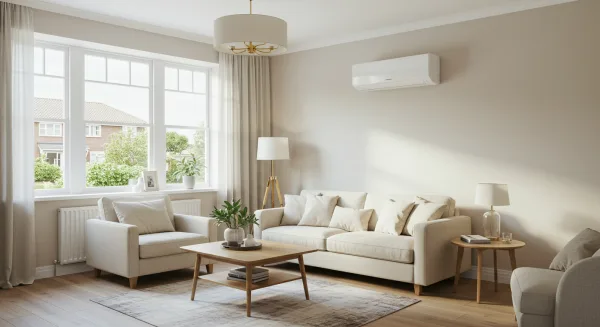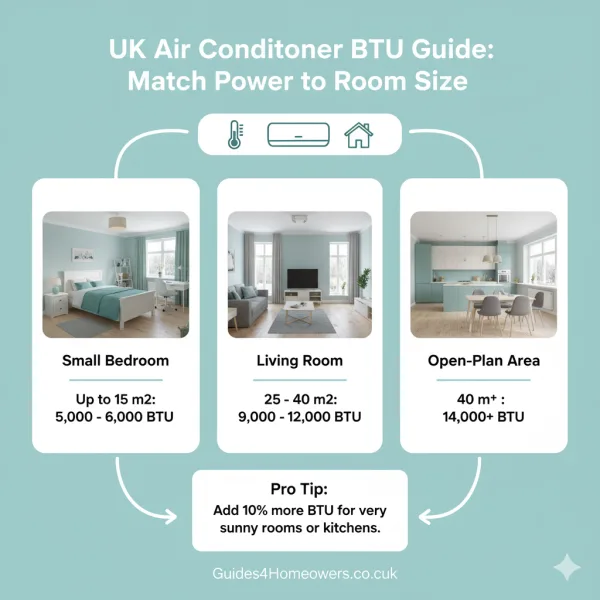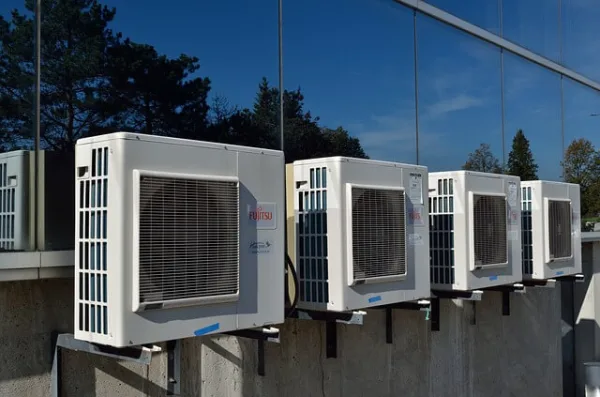With UK summers getting warmer, air conditioning is fast becoming a household essential rather than a luxury. But choosing the right unit can be confusing, with different types, sizes, and a host of features to consider. Buying the wrong one can lead to inefficient cooling and high energy bills.
This comprehensive air conditioning buying guide will walk you through everything you need to know to select the perfect unit for your home, ensuring you stay cool, comfortable, and energy-efficient through the next heatwave.
Table of Contents
- Step 1: Consider Your Space and Needs
- Step 2: Choose the Right Type of Air Conditioner
- Step 3: Calculate the Right Power (BTU) for Your Room
- Step 4: Look for Key Features and Efficiency
- How Much Do Air Conditioning Units Cost?
- Frequently Asked Questions

Step 1: Consider Your Space and Needs
Before looking at any models, first assess your own situation. Answering these simple questions will narrow down your options significantly.
- How big is the room? The size of the space you want to cool is the single most important factor. A small bedroom has very different needs from a large, open-plan living area.
- Do you have vent access? All air conditioners generate hot air that must be vented outside. For most portable units, this means running a hose out of a window. For split units, this involves a permanent installation through an external wall.
- What is your property type? If you own your home, you have the freedom to install permanent units. If you’re renting or live in a flat with restrictions, a portable or window unit might be your only option.
- How much noise can you tolerate? All AC units make noise, but some are much louder than others. If the unit is for a bedroom, noise level will be a critical factor.
Step 2: Choose the Right Type of Air Conditioner
There are three main types of air conditioners suitable for UK homes. Each has distinct advantages and disadvantages.
1. Portable Air Conditioners
These are standalone units on wheels that can be moved from room to room. They work by drawing in warm air, cooling it, and expelling the collected heat and moisture outside through a large exhaust hose.
- Pros: Lower upfront cost, no permanent installation required, easy to set up and store.
- Cons: The least efficient type, can be noisy, and the exhaust hose can be cumbersome.
- Best for: Renters, cooling small-to-medium-sized single rooms, or those on a tighter budget. See our reviews of the best portable air conditioners to compare models.
2. Ductless (Mini-Split) Air Conditioners
This system has two main parts: an outdoor compressor unit and a slim, indoor wall-mounted unit. They are connected by refrigerant pipes that run through a small hole in the wall. You can connect multiple indoor units to a single outdoor unit to cool several rooms.
- Pros: Very efficient and powerful, extremely quiet indoor operation, provides a sleek and permanent cooling solution. Many models also offer heating.
- Cons: Highest upfront cost and requires professional installation.
- Best for: Homeowners looking for a highly effective and permanent solution for one or more rooms.
3. Window Air Conditioners
These are self-contained units designed to be mounted in a window frame. They work by venting heat directly out of the back while blowing cool air into the room from the front.
- Pros: More efficient and powerful than a portable unit, relatively easy to install.
- Cons: Blocks a window, can be a security concern, and not suitable for all UK window types (works best with sash windows).
- Best for: Small rooms in flats or homes where a permanent split system isn’t an option.
Step 3: Calculate the Right Power (BTU) for Your Room
The cooling power of an air conditioner is measured in British Thermal Units (BTU). It’s crucial to get this right:
- Too low a BTU: The unit will run constantly and struggle to cool the room, wasting energy.
- Too high a BTU: The unit will cool the room too quickly without properly dehumidifying the air, leaving it feeling cold and clammy.
While online calculators can give a precise figure, here’s a reliable guide for standard ceiling heights:
| Room Size (square metres) | Recommended BTUs |
| Up to 15 m² (Small Bedroom) | 5,000 – 6,000 BTU |
| 15 – 25 m² (Large Bedroom) | 7,000 – 8,000 BTU |
| 25 – 40 m² (Living Room) | 9,000 – 12,000 BTU |
| 40 m²+ (Open-Plan Area) | 14,000+ BTU |
Pro Tip: Add 10% to your required BTU for very sunny, south-facing rooms or kitchens with heat-generating appliances.

Step 4: Look for Key Features and Efficiency
Modern air conditioners come with features that can significantly improve comfort and reduce running costs.
- Energy Efficiency: Look for the unit’s energy rating, from A+++ (most efficient) down to G. A more efficient unit will cost more initially but save you money on electricity bills in the long run. Learn more with the Energy Saving Trust’s guide to understanding energy labels.
- Adjustable Thermostat: This allows you to set and maintain a precise temperature, preventing the unit from running unnecessarily.
- Timer: A 24-hour timer lets you program the unit to turn on before you get home or switch off after you’ve fallen asleep.
- Sleep/Quiet Mode: This function slows the fan speed to reduce noise, making it essential for bedrooms.
- Multiple Functions: Many units offer extra modes. A ‘Dehumidify’ setting is great for damp days, and some models even provide heating, acting as an alternative to products like the Wall Mounted Radiators in the winter.
How Much Do Air Conditioning Units Cost?
Prices vary widely based on type, power, and brand. Here is a rough guide to what you can expect to pay for the unit itself:
- Portable Units: £300 – £700
- Window Units: £400 – £800
- Ductless / Mini-Split Units: £600 – £2,000+ (plus professional installation costs).
Frequently Asked Questions
1. Are air conditioners expensive to run? Running costs depend on the unit’s efficiency, how often you use it, and your electricity tariff. A modern, efficient unit can cost as little as 25-50p per hour to run.
2. Do I need to empty water from a portable air conditioner? Yes. Most portable units collect moisture from the air in an internal reservoir that needs to be emptied periodically. Some models have an auto-evaporation feature or a continuous drainage hose to reduce this task, similar to the functionality of the.
3. Can I install a mini-split system myself? No. A mini-split system contains refrigerant gas and requires a qualified F-Gas registered engineer for safe and legal installation.
What’s the most important feature you look for in an air conditioning unit? Share your thoughts in the comments!
For more expert advice on home energy, appliances, and maintenance, sign up for our free newsletter.






